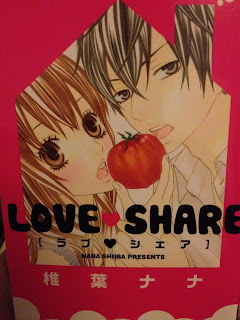The title is really self explanatory, and by manga I mean those that are not yet English translated. Just plain raw manga. The question is, "Is it really effective?" I'm just offering a way which is popular among people who study Nihongo and who are also manga readers. I believe that it's not just "effective" on its own that's why I called it "practice." You can do this if you want to take breaks from studying Nihongo so that while you have fun, you can also practice your reading or even learn new words. I will now explain the benefits brought by practicing Nihongo through manga reading.
1. You may learn new vocabulary
I mostly own shoujo manga and in this sort of manga, conversational words are present. If you are prioritizing in being able to speak conversational Nihongo, it is helpful to read shoujo manga. The reason for this is that there are words that are mostly found in conversations that one might not be familiar of, and through experience in reading manga, they can pick up those words and help remember them. Below are some examples of a shoujo manga.
Bokura Ga Ita, Volume 16.
Switch Girl, Volume 8.
2. You may learn new Kanji
Mangas are usually written with kanji but most of them have furigana or those little hiragana characters beside them for readers who are not familiar with those kanji characters written. This is in fact the most beneficial role of reading manga while learning Nihongo, in my opinion. Why? Because reading the kanji character while having its pronunciation beside it and knowing what it means/how the word can be used is very much helpful.
Mangas are usually written with kanji but most of them have furigana or those little hiragana characters beside them for readers who are not familiar with those kanji characters written. This is in fact the most beneficial role of reading manga while learning Nihongo, in my opinion. Why? Because reading the kanji character while having its pronunciation beside it and knowing what it means/how the word can be used is very much helpful.
Example of manga that has furigana beside the kanji characters.
That strip is from the manga Love Share by Nana Shiba, which is a one shot tankobon manga.
3. You practice your reading skills
Whenever I read mangas in Japanese, I always find myself exhausted because of having to read those characters. However, I do always feel that as I'm progressing with my reading, I read faster and I feel that it really helps me get pumped up in learning Nihongo. Also, if you are curious with the story, you'll just continue reading on and on until you finish it. Once you've finished reading, you won't even notice that you read a lot of Nihongo characters.
Whenever I read mangas in Japanese, I always find myself exhausted because of having to read those characters. However, I do always feel that as I'm progressing with my reading, I read faster and I feel that it really helps me get pumped up in learning Nihongo. Also, if you are curious with the story, you'll just continue reading on and on until you finish it. Once you've finished reading, you won't even notice that you read a lot of Nihongo characters.
4. You enjoy!
People read comics/manga to enjoy and by reading it in Nihongo, you will also be able to enjoy while getting yourself all immersed in reading Nihongo. That's why I suggest that if you want to try reading manga in Nihongo, you should buy something that you might like or in a genre that you like.
If you want to take it to the next level, try reading a manga like this, where there are no furigana for common Kanji words.
K-On! College
Remember, when studying, it is up to you to find other ways in which you can practice and review. Don't just close yourself to your usual study habits because you might now know what you're missing out. There's no harm in trying this method of practicing and learning Nihongo because words learned from experience when learning a language has a better chance of being remembered than those other concepts learned from lessons or books.






No comments:
Post a Comment